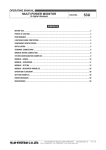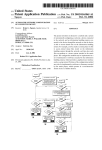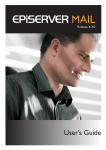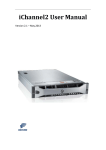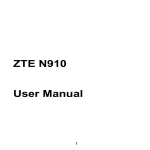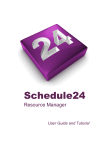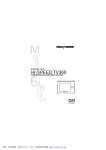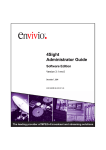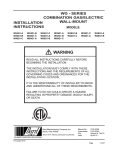Download Gefen EXT-HD-DSMP
Transcript
® User Ma Manual <pull < <p p Confi onfig> <p <pul u ullMo de va alue=” lue enabl enable” e /> < <di <d dis isab isabl i isa s sa sab bl b le / /> > <ena nable e> <pu pullUR URL value=”192 ”192.168 168.2 2.70” 70” /> / <set tting ngP Pull value=”192.168.2.70” /> <sc ched edule le ePull value value=”192 ”192.168 168.2 2.70/sche 70/schedules dules” ” /> < <pla p ayli ist tPull value=”192.168.2.70/play /p ylists” /> / <co onte tent ntP Pull value=”192.168.2.70/media” /> <p < <pul pul llLo LogU gU Upload l d value l e=”192 ”192.168 168.2 2.70” 70” /> <us serNa se ame e value=”User” /> < <u u use us se serP Pas ss value=”Pass” /> < <p po po or ort rt val lue= ue=”21” 21 /> <s <s sy y yn nc cMe Medi ia value=”disable” /> < <sy <s s sy yn y nc cP P Pl lay ylist value=”disable” /> < <sy sy sy yn nc cS S Sc che edule value value=”dis = disable” able /> </en </ na nab abl ble> e> .. .. . .. .. .. </p pu ul ull ll lCo C Co on on nfi fig g> > www.gefen.com ASKING FOR ASSISTANCE Technical Support: Telephone Fax (818) 772-9100 (800) 545-6900 (818) 772-9120 Technical Support Hours: 8:00 AM to 5:00 PM Monday through Friday, Pacific Time Write To: Gefen, LLC c/o Customer Service 20600 Nordhoff St Chatsworth, CA 91311 [email protected] www.gefen.com Notice Gefen, LLC reserves the right to make changes in the hardware, packaging and any accompanying documentation without prior written notice. Hi-Def Digital Signage Media Player is a trademark of Gefen, LLC HDMI, the HDMI logo, and High-Definition Multimedia Interface are trademarks or registered trademarks of HDMI Licensing in the United States and other countries. VMWare, the VMWare “boxes” logo and design, Virtual SMP, and vMotion are registered trademarks of VMWare, Inc. in the United States and/or other jurisdictions. © 2011 Gefen, LLC, All Rights Reserved All trademarks are the property of their respective owners. Rev A1 CONTENTS 1 Introduction 2 Operation Notes 3 Features 4 Preparing your Computer 4 Installing VMWare® Player 4 Starting the CMS 7 CMS Tutorial 8 Managing the Content 11 Managing the Playlist 16 Managing the Schedule 24 Managing Device Groups 28 Viewing Status Reports 30 Creating the Settings XML File INTRODUCTION Congratulations on your purchase of the Content Management System for the Hi-Def Digital Signage Media Player. Your complete satisfaction is very important to us. Gefen Gefen delivers innovative, progressive computer and electronics add-on solutions that harness integration, extension, distribution and conversion technologies. Gefen’s reliable plug-and-play products, supplement cross-platform computer systems, professional audio/video environments, and HDTV systems of all sizes with hard-working solutions that are easy to implement and simple to operate. The Gefen Content Management System The Content Management System (CMS) is a software application developed for the Hi-Def Digital Signage Media Player to simplify the implementation and the daily management of Digital Signage content and scheduling. From hospitality to advertising, education and business communications, the Content Management System provides users a simple and general purpose interface to manage content on a single Hi-Def Digital Signage Media Player on a network. 1 OPERATION NOTES READ THESE NOTES BEFORE INSTALLING OR OPERATING THE CONTENT MANAGEMENT SOFTWARE • This Content Management System is designed to manage multiple Hi-Def Digital Signage Media Players on a network. • This product requires that VMWare Player be installed, before using the CMS. • A USB device must be connected to the Hi-Def Digital Signage Media Player at all times, while using the CMS. • The Content Management System supports Windows 7® and Windows XP®. Both 32-bit and 64-bit versions of these operating systems are supported. 2 FEATURES Features • Manage multiple Hi-Def Digital Signage Media Players in Pull Mode • Create / edit playlists and schedules • Manage media content • Create groups to manage multiple boxes. Package Includes (1) Content Management Software (1) User Manual 3 PREPARING YOUR COMPUTER Installing VMWare® Player In order to use the CMS with the Hi-Def Digital Signage Media Players on your network, you must install VMWare® Player. Go to http://www.vmware.com to download and install VMWare® Player. Follow the instructions provided by the installation wizard. Starting the CMS To use the CMS, you must first use the VMWare® Player to open a virtual machine. The virtual machine file can be identified by the *.vmx extension. 1. Launch VMWare Player by selecting Start > Programs > VMWare > VMWare Player or double-clicking on the icon located on the Windows® desktop. 2. Once the following screen is displayed, click on Open a Virtual Machine. 4 STARTING THE CMS 3. In the Open Virtual Machine dialog box, select the GefenCMS.vmx file and then click the Open button on the dialog box to load the file. 4. After the GefenCMS.vmx file has been loaded, click Play virtual machine. 5 STARTING THE CMS 5. After a few moments, the Configuration Console will be displayed, as shown below. 6. Open your Web browser and type in the IP address displayed on this screen. The IP address listed in the Configuration Console is the defaultt IP address and can be changed based on the network requirements. 6 CMS TUTORIAL CMS Home The CMS Home page provides the starting point for every project. Each of the six (6) buttons on the CMS Home page manages a separate stage and are ordered in the way each step should be completed. Manage Groups Manage groups. Create Settings XML File Create / customize the settings.xml file using a user-friendly interface. Manage Schedule Manage the schedule.gsh file. View Device Status Access the Media Player log files. Manage Playlist Manage the playlist.gpl file. Manage Content Allows you to manage your media content (upload / download). 7 CMS TUTORIAL Managing the Content 1. Click on the Manage Contentt button to display the Manage Your Content page. 8 CMS TUTORIAL 2. Click on Upload a file. Upload Large Files Uploading large files may cause a time-out or other errors. Check this box when uploading larger files. Only one file can be uploaded at a time. 3. Select the desired media file in the selection dialog and then click Open. 9 CMS TUTORIAL NOTE: The Gefen CMS supports drag-and-drop plus multiple file selection on both Mozilla Firefox® and Google Chrome™ browsers. It is recommended to use the latest version of either browser. Once the upload begins, the Gefen CMS will display the upload progress. You can click the Cancel button at any time to abort the upload process. If the upload is successful, the file will be displayed under Browse / Remove Media files. To remove files, place a check box next to the file you want to delete. Then, click the Remove Selected d button. 10 CMS TUTORIAL Managing the Playlist 1. Click on the Manage Playlistt button. The Gefen Playlist Managementt page will be displayed: 11 CMS TUTORIAL Currently, we don’t have any playlists. Any existing playlists would be listed in the Playlist drop-down list. 2. Create a new playlist by clicking the Add New w link. 12 CMS TUTORIAL 3. Provide a name for the playlist. For this tutorial, you can use the name “myplaylist”. 4. Since we have already uploaded some media content (2.mov), click the Select a Media File pull-down list to select the content. 13 CMS TUTORIAL The illustration below shows that the media file 2.mov has been selected for our playlist. 5. If you have additional media content to add to the playlist, you will need to click the Add More Rowss link. Each media file must have its own row. Use the Remove Row w link to delete a row. 6. To upload the playlist, click the Add button. ADVANCED: By adding the media file to our playlist, our file (myplaylist.gpl) would look like this: <media> <FileName>2.mov</FileName> </media> Using Add More Rowss (plus adding more content) would result in adding additional media events to the playlist file, such as: <media> <FileName>3.mov</FileName> </media> <media> <FileName>big.mov</FileName> </media> Pressing Remove Row w would delete the selected media from the playlist. 14 CMS TUTORIAL 7. After the playlist has been successfully added, the Add button will change to an Update button. The current playlist is now also visible from the Playlist pull-down list. 8. If you want to add more content to the currently selected playlist, make sure that you press the Update button. 15 CMS TUTORIAL Managing the Schedule 1. Click on the Manage Schedule button. This is where you assign a playlist or media content to be played in a given day, time, and period. The Gefen Schedule Managementt page will be displayed: 16 CMS TUTORIAL 2. Since we don’t have a schedule yet, we need to create one. Click the Add New w link under Add new or edit Schedule: 17 CMS TUTORIAL 3. After clicking the Add New link, enter the name of the schedule file in the provided box. In the example below, we’ve used the name “myschedule”. 18 CMS TUTORIAL 4. Next, select the playlist (or Media File) to be placed in the schedule file. As mentioned earlier, the schedule file can accommodate both Media Files and Playlist Files. For this example, select the Playlist (myplaylist.gpl) from the pp top pull-down list,, as shown below: 5. Click the Add d button to upload the Schedule File (myschedule.gsh). 19 CMS TUTORIAL 6. Finally, select the day(s) and time(s) that you want the content to be played back. We’re going to start with selecting the days when we want the content to be played back. In this example, we’re going to select Mondays, Tuesdays, and Thursdays. Click the mouse to place a check mark next to the days of the week you want. Click the mouse again to remove the check mark and unselect the day(s). NOTE: The top row of days cannot be changed. By default, if you do not select any days of the week, the content will be played every day of the week (Sunday - Saturday). 20 CMS TUTORIAL 7. Next, select the Start Time and End Time. As before, with selecting the days, if a Start Time and End Time are not entered, then the content will play all day long (12:00:00 - 23:59:59). For this example, we’re going to have the content play from 8:00 am in the morning until 5:00 pm in the evening. NOTE: The Content Management System (CMS) only recognizes a 24-hour clock. All Start Times and End Times must be entered as such. When entering the Start Time and End Time, the full time must be entered as HH:MM:SS. Each field will automatically display (as shown above) the correct format while the time values are entered. If the time value is incomplete (e.g. seconds are not entered), after proceeding to the next field, the time field will be erased and you will need to re-enter the data. 21 CMS TUTORIAL 7. Finally, we need to set the Start Date and End Date. Although we have already set the days of the week, the Start Date and End Date end allow you to repeat the currently scheduled days for as many weeks as desired. 8. Clicking the Start Date field will display a calendar widget. Select the desired day by clicking on it. The Start Date field will now display the selected date. 9. Perform the same procedure for the End Date. In the example below, we selected December 12, 2011 for the Start Date and December 23, 2011 for the End Date. The current date will outlined in yellow. 22 CMS TUTORIAL 10. If you want to add additional events to the schedule file, click the Add More Eventss link. Each event has its own row. Use the Remove Row w link to delete the current event from the schedule file. d button to add the schedule file. Click the Delete button to 11. Click the Add delete the currently selected schedule file. 12. After the schedule file has been successfully added, the Add d button will change to an Update button. To make changes to the currently selected schedule (located in the Schedule pull-down list), click the Update button. ADVANCED: When using the Add More Eventss link, the schedule file is updated with a new event, as illustrated below: <Event> <StartDate>12/12/2011</StartDate> <EndDate>12/23/2011</EndDate> <DayOfWeek>0,1,1,0,1,0,0</DayOfWeek> <EventStart>08:00:00</EventStart> <EventEnd>17:00:00</EventEnd> <FileName>/playlists/myplaylist.gpl</FileName> </Event> Pressing Remove Row w would delete the current event from the schedule file. 23 CMS TUTORIAL Managing Device Groups Using the Manage Device Groups page allows you to manage multiple Hi-Def Digital Signage Media Players on a network. This is the main purpose of the CMS. 1. Click on the Manage Groupss button to display the Manage Device Groups page. 24 CMS TUTORIAL 2. Since no groups have been created yet, click the Add New link to create a group. If a group exists, it can be selected from the Select Group to Update pulldown list list. 3. Type the name of the group. 25 CMS TUTORIAL 2. Select the schedule file from the pull-down list. In this example, the schedule file is myschedule.gsh. 3. Click the Add d button to create the group. 26 CMS TUTORIAL Once the group is created, the group name will appear in the Select Group to Update pull-down list. 4. Use the edit button to upload the associated files (schedule file, playlist file, and content) to the current group. Use the Delete button to remove the group. 27 CMS TUTORIAL Status Reports Using the View Box Status page allows you to view the log files which are generated by the Hi-Def Digital Signage Media Player. 1. Click on the View Device Status (log info) button to display the View Box Status page. 28 CMS TUTORIAL After a log file is selected from the Groups pull-down list, the following information is listed in a column under the View Box Status header. In order to view a log file, you may be required to enter your user name and password. To view the log file, click on the link. You can also right-click and select “Save As...” to save the log file to your computer. NOTE: In order to access a log file from the server, the default login is ftp and the password is pass. The default login info can be changed but is beyond the scope of this manual. If you require support on changing the default login, contact VMWare. ID Columns All log file information is separated into five (5) different columns displayed under the View Box Status header: Group Name, MAC Address / Log File, Status (Last Played), Update Time, and Delete (status). Remove Deletes the currently selected log file Groups Click the arrow on the pulldown list box to select the log file to be viewed. 29 CMS TUTORIAL Creating the Settings XML File Using the View Box Status page allows you to view the log files which are generated by the Hi-Def Digital Signage Media Player. 1. Click on the Create Settings XML File button to display the Create Settings page. 30 CMS TUTORIAL 2. Click the Create Settings XML File button to create the settings.xml file. The settings.xml file contains all information required by the Hi-Def Digital Signage Media Player to function correctly. 3. Create a name for the Hi-Def Digital Signage Media Player device and type it in the Device Name field. In the example below, the Device Name is set to my_first_device. 4. Select the IP Configuration from the IP Config drop-down list. For DHCP configuration, select Automatic. If you have a user-assigned IP address for the Media Player, select Manual. 31 CMS TUTORIAL 5. For the OSD Lockk field, select Disable or Enable. If no password is required to access the OSD, then select Disable. Otherwise, select Enable. Refer to the Hi-Def Digital Signage Media Player User Manuall for information on setting the OSD password. 6. Set the Reboot Config to Disable or Enable. This option can be used in rare cases when the Media Player has exhibited abnormal behavior and performing a reboot returns the Media Player to normal operation. If the Reboot Config is set to Enable, the Reboot Time field will be displayed. It is recommended to set the Reboot Time, during a period when content is not scheduled to play. After the reboot procedure has completed, the Media Player will continue with the current schedule. 7. Select the Time Zone (GMT) from the Timezone drop-down list. 32 CMS TUTORIAL 8. Select Yes or No from the Daylight Saving g drop-down list. 9. Set the Time Mode by selecting either External or Internal from the drop-down list. When using schedules, it is highly recommended that an NTP server be used to maintain all time settings. Refer to the Hi-Def Digital Signage Media Player User Manuall for more information. 10. Provide the NTP server address(s) if using the External Time Mode setting. 11. If you are using Push Mode, set the Push Mode drop-down list to Enable. Push Mode describes a process whereby content is (manually) “pushed to” the Hi-Def Digital Signage Media Player using an FTP client. In this configuration, the Hi-Def Digital Signage Media Player becomes the FTP server. Refer to the Hi-Def Digital Signage Media Player User Manuall for more information on this feature. 33 CMS TUTORIAL 12. Set Pull Mode to Enable or Disable. When we refer to Pull Mode, we are describing a process whereby content is (automatically) “pulled from” an FTP server to the Hi-Def Digital Signage Media Player. In this configuration, the Hi-Def Digital Signage Media Player becomes the FTP client. The CMS is designed specifically for managing multiple units on a network. Refer to the Hi-Def Digital Signage Media Player User Manuall for more information on this feature. 13. Use the pull-down list to select the Group that this settings.xml file will be associated with. In the example below, the mygroup Group has been selected. 34 CMS TUTORIAL 14. The Pull URL, Username, Password, and Portt fields will automatically be filled in for you. You should not change the values in any of these fields. 15. Enabling Sync Media will instruct the Hi-Def Digital Signage Media Player to receive new content while erasing current content. Disabling Sync Media will instruct the Hi-Def Digital Signage Media Player to receive new content without deleting the current content. One advantage of enabling Sync Media is that it will reduce the space requirement for media content on the USB drive. Refer to the Hi-Def Digital Signage Media Player User Manuall for more information on this feature. 35 CMS TUTORIAL 16. Sync Playlist and Sync Schedule function in the same way as Sync Media. If either of these settings are enabled, then the new schedule file and/or playlist file will be updated from the server to the Media Player. The current schedule file and playlist(s) will be replaced with the new files. Refer to the Hi-Def Digital Signage Media Player User Manuall for more information on these features. 17. Set the Pull Repeat value to specify when the Hi-Def Digital Signage Media Player will pull content from the server. If you want to only pull content on a daily basis, then set the Pull Repeat value to Daily. Conversely, if you want to pull content on an hourly basis, then set the Pull Repeat value to Hourly. Pull Mode can be disabled by setting the Pull Repeat value to Never. 18. Set the Start Time. The maximum value for the Pull Repeat Start Time is 23:59. Refer to the Hi-Def Digital Signage Media Player User Manuall for more information on this feature. 19. The Set Active Schedule pull-down list. If only one schedule file is present, then this field will automatically be assigned once the group is selected (see Step 11). 20. Select the output resolution using the Display pull-down list. Refer to the Hi-Def Digital Signage Media Player User Manuall for more details on available output resolutions. 21. The Video Reduce option enables or disables the underscan mode. 22. Save the settings.xml file to the USB drive (or external storage) by clicking the Save As File button. After the XML file is saved to the USB device, connect the USB device to the Media Player. Once the Media Player is powered, the settings.xml file will be processed by the Media Player and the associated playlist and schedule files will be executed. Refer to the Hi-Def Digital Signage Media Player User Manuall for detailed information on file nomenclature and functionality. 23. When editing an existing settings.xml file, use the Save To Selected Group button. The file is being saved to the server. Since the Media Player is in Pull Mode, the changes in the settings.xml file will be applied after the next Pull event. 36 *MA-HD-HDSMP-CMS* Rev A1 20600 Nordhoff St., Chatsworth CA 91311 1-800-545-6900 818-772-9100 www.gefen.com fax: 818-772-9120 [email protected]











































